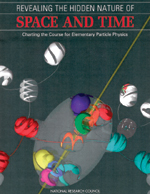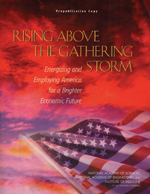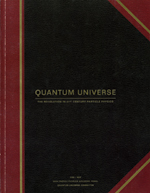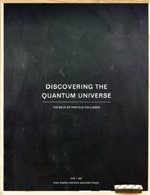|
A Report Like No Other Can the unique EPP2010 panel steer US particle physics away from its looming crisis? Physicists and policy makers are depending on it. Chuck Shank, former Director of Lawrence Berkeley National Laboratory (and not a particle physicist), carried the advocacy of the EPP2010 report to Fermilab. Shank told the crowd in Ramsey Auditorium: "I went from being an agnostic supporter to being truly excited about what you can do in this field The intellectual depth is just amazing." Photo: Reidar Hahn, Fermilab |
An urgent joint summons in 2004 from the US Department of Energy and the National Science Foundation described an imminent crisis in the field of particle physics. Responding to the request, the National Research Council proposed a risky experiment: forming an advisory panel with broad representation within and beyond the science community, and with particle physicists in the minority.
When this advisory panel, known as EPP2010, set out on its investigations in late 2004, the membership included an economist and president emeritus of Princeton University as chair; three Nobel Prize winners (two in Physics, one in Medicine); the former CEO of a technology giant; an astronomer; a former national laboratory director; theoretical physicists; a former White House Office of Management and Budget official; condensed matter physicists; a former Presidential science advisor; and an array of distinguished particle and accelerator physicists. The hope: a panel with such a unique make-up would have a wider impact than previous scientific committees.
With the release of Revealing the Hidden Nature of Space and Time: Charting the Course for Elementary Particle Physics in April 2006, the first indications are that the experiment was a success.
"This is an important opportunity for the US physics community," says the University of Chicago's Vice-President for Research and for Argonne National Laboratory, Thomas Rosenbaum, who closely followed the release of the report. "There is the importance of the physics itself and its ability to attract and retain the best talent in the world. The report is particularly impressive because it was not made up of just particle physicists. Having economists, biologists, and science policy makers on the panel lends additional credibility to the report."
Issuing the charge
Once every decade the National Academies' National Research Council brings together committees of experts in all areas of science and technology to review each field. These experts serve pro bono to address critical national issues and give advice to the federal government and the public. Even though the last study of particle physics occurred in 1998, Robin Staffin, Associate Director of High Energy Physics in the US Department of Energy's Office of Science; and Michael Turner, then-Assistant Director for Mathematical and Physical Sciences in the National Science Foundation, saw the need to advance the schedule for a new study. In November 2004, they charged the EPP2010 committee to: "Identify, articulate, and prioritize the scientific questions and opportunities that define elementary-particle physics. Recommend a 15-year implementation plan with realistic, ordered priorities to realize these opportunities."
Five years of flat federal funding, the start-up of the Large Hadron Collider (LHC) in Europe in 2007, and increasing uncertainty about the future of US particle physics made such a rigorous report a necessity. Jonathan Bagger, an EPP2010 committee member and particle physicist at The Johns Hopkins University, is a veteran of many advisory committees. In 2001, he co-chaired a DOEsponsored committee with International Linear Collider Global Design Effort director Barry Barish, producing a report with the first strong recommendation for the field of particle physics to make the ILC a high priority.
"The difference between now and five years ago is that then, we were looking forward to Run II and the LHC was farther off on the horizon," Bagger says, referring to Tevatron Collider Run II at Fermilab. "Run II is a reality now, and the LHC is looming. We are just that much closer to the time of transition, and that certainly increases the urgency, the opportunity, and even the peril."
The status of the particle physics program within US laboratories has changed dramatically. The primary mission of Stanford Linear Accelerator Center has broadened to include a larger program in light sources and astrophysics. Fermilab will soon be the sole remaining US lab focused on particle physics. The cancellation of particle physics projects such as BTeV and RSVP in 2005 left the United States without a major acceleratorbased experiment to follow the eventual shutdown of Fermilab's Tevatron in 2009. Because of the dramatic transitions in the field, the EPP2010 committee's report recommends as a priority second only to fully exploiting the opportunities afforded by the Large Hadron Collider at CERN, that the United States "do what is necessary to mount a compelling bid to build the proposed International Linear Collider on US soil."
|
Outlined in priority order as designated by EPP2010, the report recommends that the United States:
|
Why is this report different from others?
Reaching this unanimous conclusion, however, was not a simple process. Skeptical at first, several members of the panel required a great deal of convincing with a number of presentations from particle physicists across the country before endorsing the recommendations for future plans. "It was a tremendous intellectual challenge to learn how to communicate with people who are not particle physicists, and it made us really hone our arguments," says Sally Dawson, head of the physics department at Brookhaven Lab and vice chair of the panel. "I feel like we took a test and passed–maybe even got an A."
Distinguishing the EPP2010 report from all other reports is the diverse make-up of the panel and the multitude of reactions following its release. "They took a very brave position," says Marc Kastner, head of the physics department at MIT and chair of the National Research Council's Solid State Sciences Committee. "It might be a gamble to say that the ILC is the thing that we must do to maintain leadership in high-energy physics, but they are probably right."
Dawson credits the success of the unique group to economist and EPP2010 Committee chair Harold Shapiro, who sat through hours of tutorial sessions with physicists. His devotion to the task further validates the conclusions in the report. At the press briefing, Shapiro cut to the chase in addressing the pending future of particle physics: "We came to the conclusion that this might be the most exciting moment for the field," he said. "Exploring the Terascale and having the technology to do it is more compelling than ever."
The entire panel went through an educational process that converted members from observers of particle physics to true believers. "I went from being an agnostic supporter to being truly excited about what you can do in this field," says Chuck Shank, panel member and former director of Lawrence Berkeley National Laboratory. "I realized that the Higgs [the particle thought responsible for giving mass to all others] is just the tip of the iceberg. The intellectual depth is just amazing."
 |
 |
 |
 |
|
Reporting on the Future |
|
Risky vs. riskier
Still haunted by the 1993 demise of the Superconducting Super Collider (SSC), a $10-billion project in Waxahachie, Texas that Congress cancelled in 1993, scientists recognize that if one field of physics is strong, all of the other branches will benefit (or vice versa). "If we learned anything from the SSC, it's that when big projects in particle physics are cancelled, it doesn't help anybody else in physics," Kastner says. "We all sink or swim together."
Physicists in condensed matter and solid state physics, for example, are more likely to support the ILC if it does not follow the same path as the SSC. "It is critical that the ILC not get started and then have big cost overruns and be cancelled," says David Tanner, a condensed matter physicist at the University of Florida and chair of the American Physical Society's Division of Condensed Matter Physics. "The ILC seems like the next step for the high-energy physics science community, but it must stay on budget and not repeat the mistakes of the SSC."
Some in the community, however, have raised concerns that the report is not "complete." While the report strongly endorses the push for the ILC, some scientists worry about a lack of proposals for intermediate projects. "This report proposes a cure for the 'fatal disease' of losing the high-energy frontier; however it does not address how to prevent the Linear Collider 'cure' from being equally fatal," says Janet Conrad, co-spokesperson of the MiniBooNE experiment at Fermilab. "It seems likely that during the 20-year period of design and construction of a linear collider, no other federally-funded HEP experiments will be conducted within the United States. If US-based high-energy physics comes to a stop, it will be hard to restart. Ways to maintain a modest but exciting US-based program need to be developed."
With no intermediate projects on the horizon, US graduate students and postdocs, who require running experiments with data to complete their theses and to publish papers, share a concern about the long-term future of the field in the United States. "It is very good to know that the physicists on the panel communicated what we are doing and why to non-physicists," says Katherine Copic, a graduate student from University of Michigan and member of Fermilab's CDF experiment, in response to the report. "The concern for younger people is the lack of intermediate jobs in the US, especially when you place all of your bets on the ILC. Is it at the expense of the neutrino program or other projects? If the ILC doesn't happen, then what? Is that it?"
On their laboratory world-tour, the panel made it a point to solicit the views of the graduate students who will make up the next generation of particle physicists. Ordaining the ILC as the future for the US particle physics program can be considered risky. But speaking in economic terms, large risks can yield large returns. And in the eyes of the panel, the ILC is a risk worth taking. "It is a risky investment, but it is the least risky that we could find," Shapiro says. "The riskiest thing that we can do is stay where we are right now."
Beyond the report
Immediately following the release of the report, panel members started on a circuit of talks in Washington, DC, and at laboratories across the country. Attracting media attention from national and international publications, the EPP2010 release made a big splash. The question now is how far the ripples will spread.
"Our hope is that it will be embraced by the High Energy Physics Advisory Panel (HEPAP) and the official advisory process so that it gets built into the day-to-day operations of the field," Bagger says. "This committee prioritized very differently from other NRC panels and left tremendous latitude and flexibility in the implementation of the priorities. In that way, the report is handed over to next advisory committees and the funding agencies for implementation."
Next up, the Particle Physics Project Prioritization Panel (P5) will propose a detailed roadmap for US particle physics over the next decade. Using the EPP2010 report as a foundation, P5 will take the plan to the next level, prioritizing specific projects and their budgets in the United States. P5 will submit a final report to the Department of Energy and the National Science Foundation by September 2006.
Even before the release of the P5 report, the CERN Council Strategy Group will issue a draft strategy document that will be the European equivalent of the EPP2010 report. The CERN Council's recommendations will have a major impact on national science programs throughout Europe and the entire global community.
|
Harold Shapiro, committee chair, economist and President Emeritus of Princeton University, declared: "We came to the conclusion that this might be the most important moment for the field." Photos: Diana Rogers, SLAC |
Rising above differences
In the meantime, members of the US particle physics community will promote the EPP2010 report to ensure that its impact will be real and long-term. Norman Augustine, head of the National Academies report that made headlines in October and influenced the US President's annual State of the Union address, is an expert when it comes to doing the necessary legwork to prevent a report from just collecting dust on a bookshelf.
Augustine's report, Rising Above the Gathering Storm, argued that as America falls behind in science education and outsources science and engineering jobs, economic crisis in this country becomes inevitable. Also a member of the EPP2010 panel, Augustine estimates that he has given some 30 talks on the Gathering Storm report.
Augustine's advice for the US particle physics community: "Start building the groundwork now to tell the public and the people who control the budget in this country what this is and why it is important." He adds: "Try to present the case together as a community, without attacking each other."
Click here to download the pdf version of this article.






